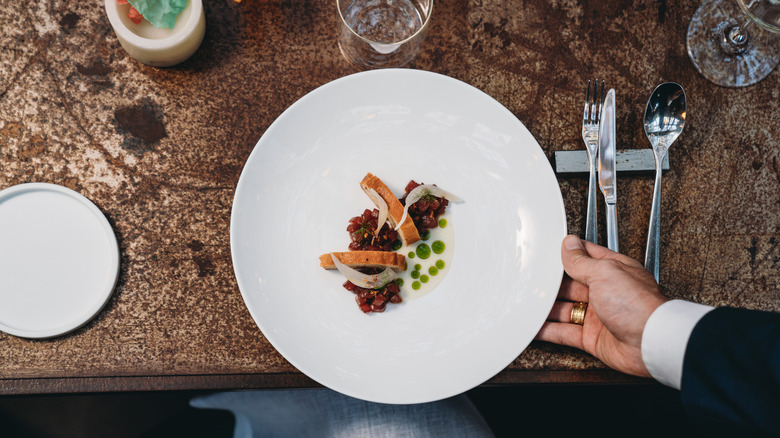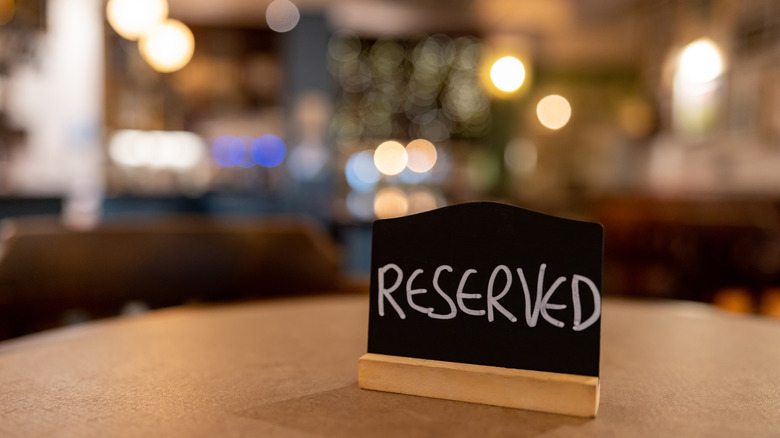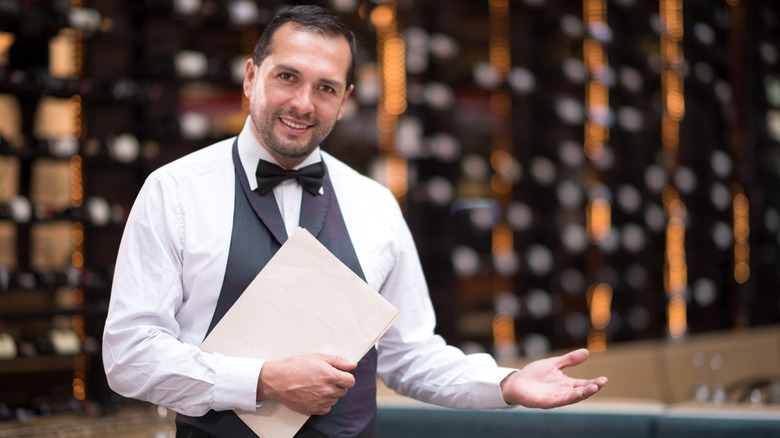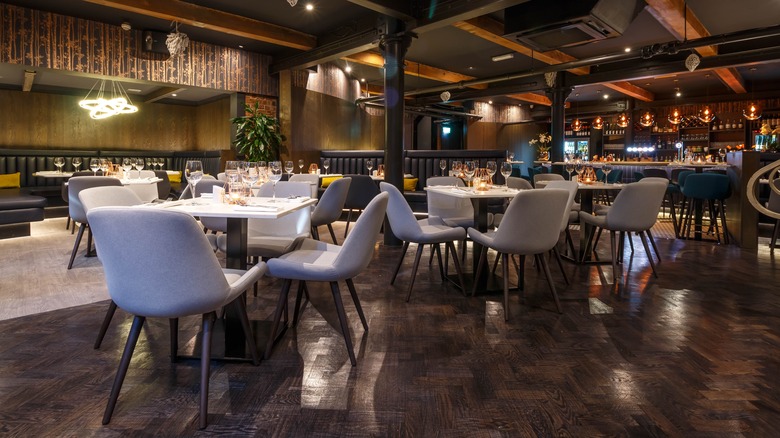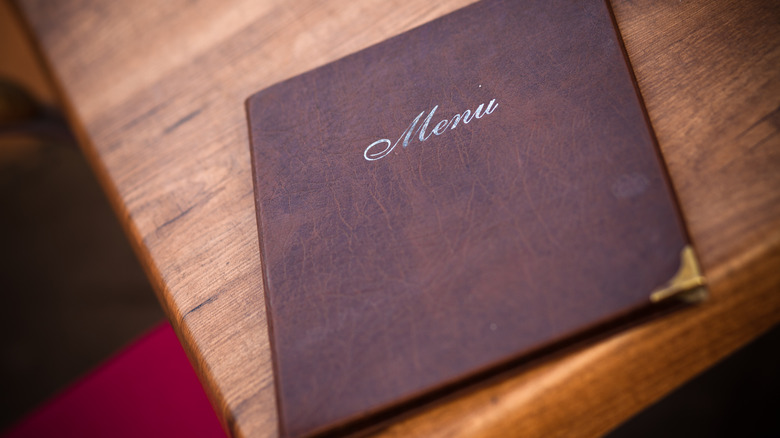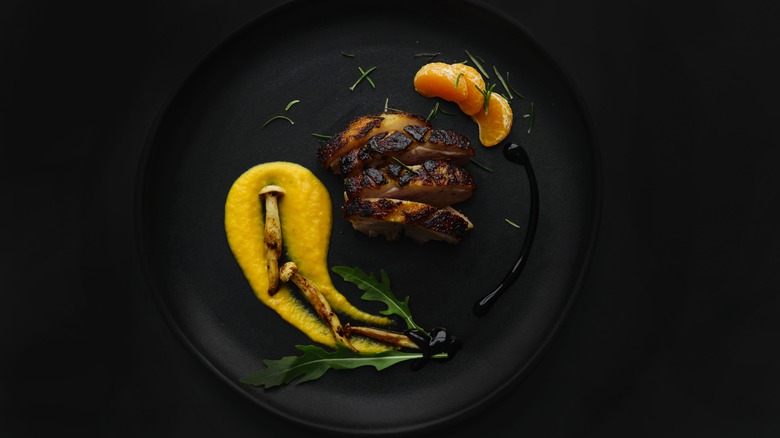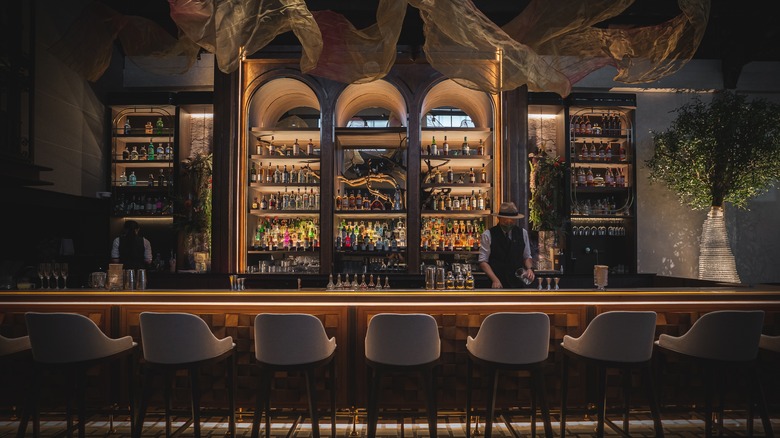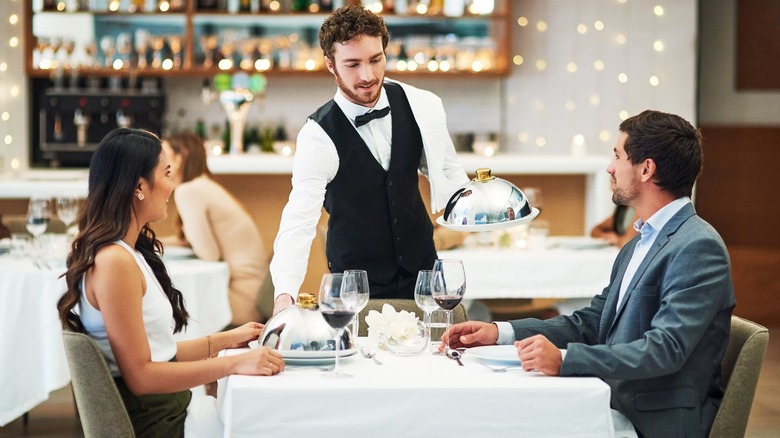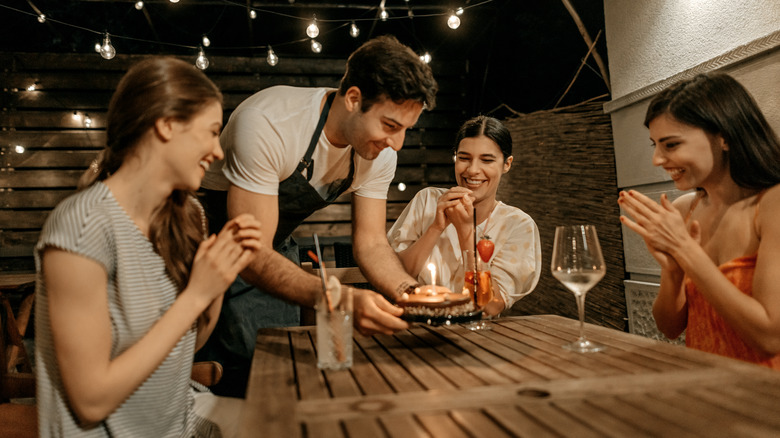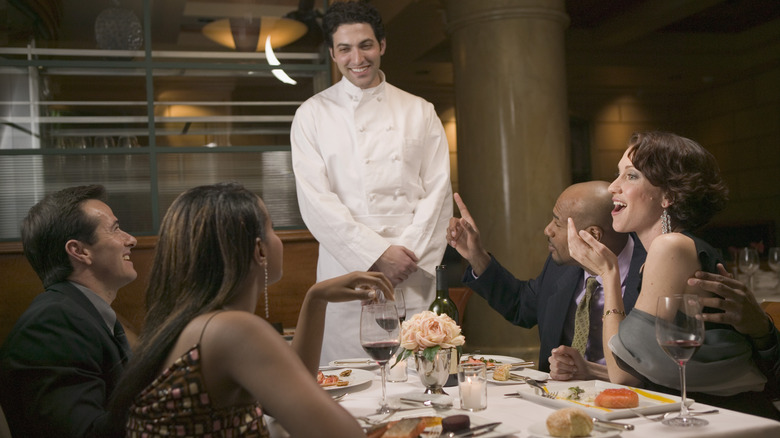10 Signs That Indicate You're Eating In A Fine Dining Restaurant
It's no secret that dining out has gotten more expensive. With food cost-driven price hikes and controversies surrounding tipping practices, indulging in a meal out has transitioned from a simple treat into a luxurious indulgence. Yet, there's something undeniably special about splurging on a night out.
We're all for a splurge now and then, especially when celebrating a milestone or special occasion, and fine dining has classically satiated the appetite for a "treat yourself" moment. After all, if you're going to shell out the cash, you may as well make the meal worth your while. But how do you know whether a restaurant will actually deliver on an out-of-this-world experience or just leave you with a bill that has you seeing stars?
Classic restaurant ranking entities like Michelin and World's 50 Best have come under fire in recent years for praising the same Euro-centric venues and ignoring innovation in the dining room. So, I decided to break down the standard building blocks of a quality restaurant experience into an easily digestible list of signs that indicate a genuine fine dining establishment. Drawing on this writer's experience working in the luxury hospitality sector, I've identified some key elements that signify a world-class eatery, each of which ensures that your time and money will be well spent.
They have a robust online presence
Running any restaurant is expensive, but maintaining a top-tier fine dining establishment is a superhuman feat. The costs involved in sourcing premium ingredients, hiring and retaining skilled staff, and providing an exceptional dining experience are substantial. Rather than spending money on traditional advertising channels, many high-end restaurants invest instead in maintaining quality websites and social media content.
In today's online world, showing attention to detail in these ever-evolving channels is a pivotal part of the guest experience. In fact, websites and social media often serve as the very first touch point between a restaurant and a potential diner. A well-designed website can convey the restaurant's ambiance, updated menu, and philosophy, providing a glimpse into what diners can expect at the brick-and-mortar location. Social media platforms, on the other hand, allow restaurants to engage with their audience on a more personal level, showcasing decision-making details like daily specials, behind-the-scenes activities, and customer testimonials.
Top industry professionals understand the critical importance of making a memorable first impression. A visually appealing and user-friendly website, along with an active and engaging social media presence, can set a restaurant apart from its competitors. Digital platforms not only attract potential diners but also help build a loyal customer base. In a world with more dining options than ever, the choice to invest in these areas is not just a strategy but a necessity for fine dining restaurants to stand out in a competitive market.
Reservations are a must
Despite their snobbish feel, reservations aren't just a way for restaurants to build a reputation for exclusivity. They're actually a crucial component in ensuring that fine-dining establishments can provide the top-tier service that you've come to expect. Running a restaurant like a well-oiled machine requires meticulous planning, and preparation is the best tool at the venue's disposal.
Fine-dining restaurants are typically located in smaller venues with fewer seats, creating an intimate and exclusive atmosphere. Combine this limited seating with intricate multi-course meals using highly seasonal ingredients and customized service, and that leaves time as a precious commodity. Reservations allow the staff to plan and execute their service precisely, ensuring that each dish is served at its peak and every detail of the dining experience is flawlessly timed. All this attention to detail is why some restaurants have begun charging people who ghost their reservations.
Just like you do your research to know what kind of restaurant experience you're about to invest in, the restaurant staff needs to be able to time everything to perfection. This enables them to set the scene for a perfect evening without breaking a sweat — at least that you can see. Behind the scenes, there is a flurry of activity, but the goal is to make it all appear seamless. By managing reservations effectively, fine dining restaurants can create an environment where your dining experience is elevated to an art form.
The arrival experience is seamless
Once the all-important reservation is made and confirmed, your work should be done. From this point on, the restaurant takes over, ensuring that your dining experience is nothing short of exceptional. Upon arrival for your reservation, you should be greeted warmly by the host and promptly seated at your meticulously prepared table. There should be no waiting around for dirty dishware and spoiled linens to be cleared; every detail should be attended to in advance, reflecting the restaurant's commitment to providing exceptional customer service.
After taking your seat, your server should greet you within moments, ideally by name, which adds a personal touch to your dining experience. This immediate attention signals that you are valued and that the restaurant is prepared to cater to your needs from the very start. Your server should offer water (still or sparkling) promptly and provide a detailed explanation of the wine list and/or cocktail program, making customized recommendations based on any preferences you choose to share. Knowledgeable and personalized service is a hallmark of fine dining and should be standard practice at any restaurant worth its stars. It's these small service details that set the bar for the very best restaurant experiences.
The ambiance is cohesive
Fine dining is characterized by attention to detail, and that goes as much for the ambiance in the dining room as the service at the door and the food on the plate. Everything from the music and the lighting to the decor and tableware should be purposeful, contributing to the overall experience instead of distracting from it. The goal is to create a harmonious environment where every element brings a little more joy to your celebratory evening.
That's not to say that all fine dining rooms need to be outfitted with white tablecloths, straight-backed chairs, and glimmering chandeliers. As tastes and trends have evolved, so too have the world's top restaurants. It's common nowadays for fine dining restaurants to adopt a more modern and relaxed approach to their decor, opting for the trendy over the traditional. Many now forgo linens altogether, opting instead for clean wooden tables, earthenware plates, and the warm, inviting glow of votive candles. The shift reflects a broader trend towards creating a dining experience that feels both luxurious and comfortable, all while adding a little character and drama.
As long as the design ethos is cohesive, a restaurant should be free to express its creativity in implementing its vision for your perfect night out. The key is consistency and intentionality; whether the style is minimalist, rustic, or downright opulent, every detail should reflect the restaurant's unique identity and enhance your overall dining experience.
The menu is short
While a short menu is not necessarily a sign of a fine dining restaurant, most eateries worth their stars keep things simple with small, thoughtful menus executed to the highest standard. These menus reflect a commitment to quality over quantity, allowing chefs to focus on perfecting each dish. Typically helmed by top-tier talent in the kitchen, fine dining restaurants aim for perfection on a plate — a feat that's nearly impossible with a Cheesecake Factory-sized menu.
The philosophy and vision of the chef play crucial roles in shaping the menu. Fine dining restaurants often specialize in a particular type or style of cuisine that emphasizes their unique culinary identity. This specialization allows chefs to hone their craft and consistently deliver exceptional dishes that highlight their expertise and creativity. These establishments also tend to prioritize highly seasonal plates, offering a rotating array of dishes built around the freshest available ingredients. This approach not only ensures peak flavor but aligns with hot-button issues like sustainable sourcing practices and supporting local producers.
To get a taste of the chef's talents, opt for the tasting menu. More often than not, fine dining restaurants will offer a multi-course, prix fixe menu that showcases the chef's greatest hits. Not only can you rest assured that these are some of the best dishes on the menu, but you don't have to make any decisions for the rest of the night. It's a win-win.
Plates are composed like a painting
It's true what they say: "You eat with your eyes first." High-achieving restaurants are intimately familiar with this old adage and go to great lengths to compose each plate with artistic precision designed to get your mouth watering before you've ever taken a bite. As anyone who has ever watched Top Chef can attest, the presentation of a dish can enhance (or detract from) its overall impact.
This doesn't mean that every ingredient is plated with tweezers. While some dishes resemble the intricate details of a Renaissance still life, some of the most enticing offerings imitate abstract art, with vibrant sauces splattered across stark white plates. The diversity in presentation styles should showcase the chef's creativity and the restaurant's unique culinary vision.
The most important thing to remember is that each element on the plate should serve a purpose. Aesthetics alone are not enough to elevate a dish from basic to bold. The visual components must complement and enhance the flavors of the final dish. For instance, vibrant green herbs might look gorgeous, but if they don't contribute to the overall flavor profile, they risk turning the dish into a case of style over substance. The highly trained chefs helming the kitchens of fine dining restaurants are adept at striking a balance between palate and palette, ensuring that every dish is a mouthwatering masterpiece designed to be delicious.
Beverages are not an afterthought
The devil is in the details and a well-curated beverage program can make or break a restaurant's fine dining ambitions. The bar should be seamlessly integrated into the restaurant in both design and drink selection, acting as an enhancement to the venue's overall experience. The wine and cocktail offerings, for example, should be designed in tandem with the food menu for optimal pairing opportunities, with a highly trained sommelier on hand to help you navigate the intricacies of the various vintages and suggest perfect pairings that elevate the dining experience.
With sober-curious experiences on the rise, fine dining restaurants should be putting as much thought into their mocktail options as their spirits. Long gone are the days of offering club soda with lime or a bottle of O'Doul's as options for those who choose not to imbibe. High-end establishments now recognize the importance of offering a curated collection of non-alcoholic spirits and concoctions crafted with house-made syrups, fresh herbs, and floral accouterments that mimic the complex flavors of classic cocktails. This shift towards sophisticated mocktails reflects a broader trend of inclusivity in fine dining, ensuring that all guests, regardless of their drinking preferences, have a memorable and enjoyable experience. If a fine dining restaurant isn't staying on top of contemporary dining trends, it's likely to quickly lose its luster.
Staff are attentive but not bothersome
Hospitality is an art form and a well-trained front-of-house staff is a key component in the recipe for a memorable fine dining experience. As we've already established, the restaurant should run like a well-oiled machine, ensuring your needs are met at every turn. Attentive staff knows how to navigate the tricky divide between providing prime service without being overbearing, striking the perfect balance to make you feel both welcomed and respected.
Once again, the foundation of this seamless service lies in meticulous preparation. When making a reservation at a fine dining restaurant, you'll typically be asked a few questions in advance, such as if you're celebrating anything or if you have any food allergies or preferences. Top-tier staff take full advantage of this intel to greet you by name and cater to your preferences without having to probe or make you repeat any of the already-provided information.
From start to finish, the experience should be tailored to you. Fine dining staff should be adept at reading the room and adjusting their service style accordingly. Whether you prefer a more interactive experience with detailed explanations of each dish and wine pairing, or a quieter, more private evening, the staff should accommodate your desires effortlessly. In addition to technical skills, the front-of-house team should exude warmth and genuine hospitality. Their goal is to make you feel like a valued guest, creating an ambiance where you can relax and savor every moment.
Surprise and delight is standard practice
From a gratis glass of champagne to celebrate a promotion to a special birthday dessert, little touches go a long way when it comes to stellar service. Fine dining establishments aim to make every moment count, prioritizing your experience over the extra cost involved in adding those generous touches that make your evening extra memorable.
You don't need to be celebrating a special occasion to benefit from this surprise and delight mentality. More often than not, fine dining restaurants will offer little touches throughout the evening to further elevate your experience. For example, meals frequently begin with an amuse-bouche or small bite from the chef crafted to whet your palate and set the tone for the courses to come. Throughout the meal, you might encounter additional gestures that further enhance the experience. A sommelier might offer you a taste of an exceptional wine or a server might bring an unexpected dish to sample. And at the end of the night, you'll likely be presented with a small post-dessert treat, such as house-made candies, cookies, or a petit four, designed to end your evening on a sweet note.
Some restaurants take these thoughtful touches a step further, sending you home with a parting gift. You might receive a box of truffles, a jar of house-made preserves, or even a menu signed by the chef. While they may seem trivial, it's these little extras that elevate the experience from satisfactory to stellar.
There's a chef's table experience
While not a requirement for a fine dining restaurant, many quality establishments offer a private or semi-private dining experience known as a chef's table. This exclusive reservation is akin to getting a behind-the-scenes peek into the creative mind of a top-tier toque. At the chef's table, you'll be treated to an intimate and immersive dining experience, where you can witness firsthand the culinary mastery that goes into each and every plate that the restaurant churns out.
Typically set in the restaurant's kitchen, the chef's table puts you right in the heart of the action, giving you a front-row seat to the wonderful world of haute cuisine. The chef's table experience usually involves a bespoke menu crafted by the chef, featuring courses inspired by seasonal produce, prime cuts of meat, and fresh seafood. These dishes serve as a showcase of the chef's particular talents and culinary vision, allowing you to savor a more unique and interactive twist on the traditional fine dining experience.
What sets the chef's table apart is the opportunity to interact directly with the chef. This intimate setting provides a rare chance to engage in culinary conversation, learn about the chef's background, and gain insights into their creative process. You can even become part of the restaurant's evolution by asking questions and providing feedback in real time.
